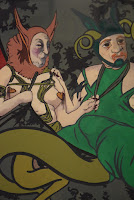As I was about to leave the Museum I realised there was a gallery on some rather interesting historical facts of the Portuguese life in illustrated paintings and brochures of Art exhibitions of the past.
I found it to be very important particularly for the younger generation who hasn't but heard about disperse facts and not been exposed to them, such as censorship. One of the sketches had been stamped by the Government entity that supervised the publishing process at the time.
My attention was equally drawn to some brochures on Art exhibitions related to the Portuguese painter Amadeo de Sousa Cardoso's exhibition in France and the first Portuguese African colonies' one in early twentieth century.
Gouache and graphite on paper - 1922 by Jorge Barradas.

Ink and grafite on paper - 1933 - by Bernardo Marques - (censored by the government for publication purposes, as seen on the right hand side).

Liberdade, Igualdade e Fraternidade (Freedom, Equality and Fraternity) - 1922 - ink, wash and gouache on paper by Jorge Barradas (left). Portuguese illustration - 1922 - ink, wash and gouache on paper by António Soares (right).



Portrait of the Portuguese writer Maria da Graça Freire - 1958 by Eduardo Mata (left). Untitled - 1947 by Cipriano Dourado (right).
I then came across four 1975 gouache on paper paintings from the series of Portuguese Folk Stories by Paula Rego, as well as some of her sketches.


A map which depicted the number of Portuguese overseas colonies brought back primary school memories. The map we had to virtually "memorise" as young children, so as not to forget the importance of Portugal and the role it played in the world, was there right in front of me ... it made me "shiver" as it used to before. Close to it stood another one stating Portugal is not a small country ... (I wonder what we could showcase now!...)



















































